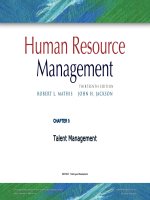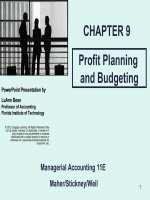Operation management 11e heizer render chapter 09
Bạn đang xem bản rút gọn của tài liệu. Xem và tải ngay bản đầy đủ của tài liệu tại đây (2.25 MB, 69 trang )
Layout Strategies
9
PowerPoint presentation to accompany
Heizer and Render
Operations Management, Eleventh Edition
Principles of Operations Management, Ninth Edition
PowerPoint slides by Jeff Heyl
© 2014
© 2014
Pearson
Pearson
Education,
Education,
Inc.Inc.
9-1
Outline
►
Global Company Profile:
McDonald’s
►
The Strategic Importance of Layout
Decisions
Types of Layout
Office Layout
Retail Layout
Warehousing and Storage Layouts
►
►
►
►
© 2014 Pearson Education, Inc.
9-2
Outline - Continued
►
►
►
►
Fixed-Position Layout
Process-Oriented Layout
Work Cells
Repetitive and ProductOriented Layout
© 2014 Pearson Education, Inc.
9-3
Learning Objectives
When you complete this chapter you
should be able to:
1. Discuss important issues in office layout
2. Define the objectives of retail layout
3. Discuss modern warehouse management
and terms such as ASRS, cross-docking,
and random stocking
4. Identify when fixed-position layouts are
appropriate
© 2014 Pearson Education, Inc.
9-4
Learning Objectives
When you complete this chapter you
should be able to:
5. Explain how to achieve a good processoriented facility layout
6. Define work cell and the requirements of a
work cell
7. Define product-oriented layout
8. Explain how to balance production flow in a
repetitive or product-oriented facility
© 2014 Pearson Education, Inc.
9-5
Innovations at McDonald’s
►
Indoor seating (1950s)
►
Drive-through window (1970s)
►
Adding breakfast to the menu (1980s)
►
Adding play areas (late 1980s)
►
Redesign of the kitchens (1990s)
►
Self-service kiosk (2004)
►
Now three separate dining sections
© 2014
© 2014
Pearson
Pearson
Education,
Education,
Inc.Inc.
9-6
Innovations at McDonald’s
►
Indoor seating (1950s)
►
►
Drive-through windowSix
(1970s)
out of the
are
Adding breakfast to the seven
menu (1980s)
layout
Adding play areas (late decisions!
1980s)
Redesign of the kitchens (1990s)
►
Self-service kiosk (2004)
►
Now three separate dining sections
►
►
© 2014
© 2014
Pearson
Pearson
Education,
Education,
Inc.Inc.
9-7
McDonald’s New Layout
▶ Seventh major innovation
▶ Redesigning all 30,000 outlets around the
world
▶ Three separate dining areas
▶ Linger zone with comfortable chairs and Wi-Fi
connections
▶ Grab and go zone with tall counters
▶ Flexible zone for kids and families
▶ Facility layout is a source of competitive
advantage
© 2014
© 2014
Pearson
Pearson
Education,
Education,
Inc.Inc.
9-8
Strategic Importance of Layout
Decisions
The objective of layout strategy
is to develop an effective and
efficient layout that will meet the
firm’s competitive requirements
© 2014 Pearson Education, Inc.
9-9
Layout Design Considerations
►
Higher utilization of space, equipment, and
people
►
Improved flow of information, materials, or
people
►
Improved employee morale and safer
working conditions
►
Improved customer/client interaction
►
Flexibility
© 2014 Pearson Education, Inc.
9 - 10
Types of Layout
1.
2.
3.
4.
5.
6.
7.
Office layout
Retail layout
Warehouse layout
Fixed-position layout
Process-oriented layout
Work-cell layout
Product-oriented layout
© 2014 Pearson Education, Inc.
9 - 11
Types of Layout
1. Office layout: Positions workers, their
equipment, and spaces/offices to
provide for movement of information
2. Retail layout: Allocates shelf space
and responds to customer behavior
3. Warehouse layout: Addresses tradeoffs between space and material
handling
© 2014 Pearson Education, Inc.
9 - 12
Types of Layout
4. Fixed-position layout: Addresses the
layout requirements of large, bulky
projects such as ships and buildings
5. Process-oriented layout: Deals with
low-volume, high-variety production
(also called job shop or intermittent
production)
© 2014 Pearson Education, Inc.
9 - 13
Types of Layout
6. Work cell layout: Arranges machinery
and equipment to focus on production
of a single product or group of related
products
7. Product-oriented layout: Seeks the
best personnel and machine
utilizations in repetitive or continuous
production
© 2014 Pearson Education, Inc.
9 - 14
Layout Strategies
TABLE 9.1
Layout Strategies
OBJECTIVES
EXAMPLES
Office
Locate workers requiring
frequent contact close to one
another
Allstate Insurance
Microsoft Corp.
Retail
Expose customer to highmargin items
Kroger’s Supermarket
Walgreen’s
Bloomingdale’s
Warehouse
(storage)
Balance low-cost storage with
low-cost material handling
Federal-Mogul’s warehouse
The Gap’s distribution center
Project (fixed
position)
Move material to the limited
storage areas around the site
Ingall Ship Building Corp.
Trump Plaza
Pittsburgh Airport
© 2014 Pearson Education, Inc.
9 - 15
Layout Strategies
TABLE 9.1
Layout Strategies
OBJECTIVES
EXAMPLES
Job Shop
(process
oriented)
Manage varied material flow for
each product
Arnold Palmer Hospital
Hard Rock Cafe
Olive Garden
Work Cell
(product
families)
Identify a product family, build
teams, cross train team
members
Hallmark Cards
Wheeled Coach Ambulances
Repetitive/
Continuous
(product
oriented)
Equalize the task time at each
workstation
Sony’s TV assembly line
Toyota Scion
© 2014 Pearson Education, Inc.
9 - 16
Good Layouts Consider
►
Material handling equipment
►
Capacity and space requirements
►
Environment and aesthetics
►
Flows of information
►
Cost of moving between various work
areas
© 2014 Pearson Education, Inc.
9 - 17
Office Layout
►
Grouping of workers, their equipment,
and spaces to provide comfort, safety,
and movement of information
►
Movement of information is main
distinction
►
Typically in state of flux due to
frequent technological changes
© 2014 Pearson Education, Inc.
9 - 18
Relationship Chart
Figure 9.1
© 2014 Pearson Education, Inc.
9 - 19
Office Layout
►
►
Three physical and social aspects
►
Proximity
►
Privacy
►
Permission
Two major trends
►
Information technology
►
Dynamic needs for space and services
© 2014 Pearson Education, Inc.
9 - 20
Supermarket Retail Layout
▶ Objective is to maximize profitability
per square foot of floor space
▶ Sales and profitability vary directly
with customer exposure
© 2014 Pearson Education, Inc.
9 - 21
Five Helpful Ideas for
Supermarket Layout
1. Locate high-draw items around the periphery of
the store
2. Use prominent locations for high-impulse and
high-margin items
3. Distribute power items to both sides of an aisle
and disperse them to increase viewing of other
items
4. Use end-aisle locations
5. Convey mission of store through careful
positioning of lead-off department
© 2014 Pearson Education, Inc.
9 - 22
Store Layout
Figure 9.2
© 2014 Pearson Education, Inc.
9 - 23
Retail Slotting
▶ Manufacturers pay fees to retailers to
get the retailers to display (slot) their
product
▶ Contributing factors
▶ Limited shelf space
▶ An increasing number of new products
▶ Better information about sales through
POS data collection
▶ Closer control of inventory
© 2014 Pearson Education, Inc.
9 - 24
Servicescapes
1. Ambient conditions - background
characteristics such as lighting, sound,
smell, and temperature
2. Spatial layout and functionality - which
involve customer
circulation path planning,
aisle characteristics, and
product grouping
3. Signs, symbols, and
artifacts - characteristics
of building design that
carry social significance
© 2014 Pearson Education, Inc.
9 - 25









